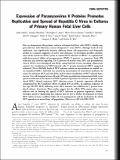| dc.contributor.author | Andrus, Linda | |
| dc.contributor.author | Marukian, Svetlana | |
| dc.contributor.author | Jones, Christopher T. | |
| dc.contributor.author | Catanese, Maria Teresa | |
| dc.contributor.author | Sheahan, Timothy P. | |
| dc.contributor.author | Schoggins, John W. | |
| dc.contributor.author | Barry, Walter T. | |
| dc.contributor.author | Dustin, Lynn B. | |
| dc.contributor.author | Trehan, Kartik | |
| dc.contributor.author | Ploss, Alexander | |
| dc.contributor.author | Rice, Charles M. | |
| dc.contributor.author | Bhatia, Sangeeta N | |
| dc.date.accessioned | 2014-03-28T17:05:51Z | |
| dc.date.available | 2014-03-28T17:05:51Z | |
| dc.date.issued | 2011-09 | |
| dc.date.submitted | 2011-05 | |
| dc.identifier.issn | 02709139 | |
| dc.identifier.issn | 1527-3350 | |
| dc.identifier.uri | http://hdl.handle.net/1721.1/85958 | |
| dc.description.abstract | Here we demonstrate that primary cultures of human fetal liver cells (HFLC) reliably support infection with laboratory strains of hepatitis C virus (HCV), although levels of virus replication vary significantly between different donor cell preparations and frequently decline in a manner suggestive of active viral clearance. To investigate possible contributions of the interferon (IFN) system to control HCV infection in HFLC, we exploited the well-characterized ability of paramyxovirus (PMV) V proteins to counteract both IFN induction and antiviral signaling. The V proteins of measles virus (MV) and parainfluenza virus 5 (PIV5) were introduced into HFLC using lentiviral vectors encoding a fluorescent reporter for visualization of HCV-infected cells. V protein-transduced HFLC supported enhanced (10 to 100-fold) levels of HCV infection relative to untransduced or control vector-transduced HFLC. Infection was assessed by measurement of virus-driven luciferase, by assays for infectious HCV and viral RNA, and by direct visualization of HCV-infected hepatocytes. Live cell imaging between 48 and 119 hours postinfection demonstrated little or no spread of infection in the absence of PMV V protein expression. In contrast, V protein-transduced HFLC showed numerous HCV infection events. V protein expression efficiently antagonized the HCV-inhibitory effects of added IFNs in HFLC. In addition, induction of the type III IFN, IL29, following acute HCV infection was inhibited in V protein-transduced cultures. Conclusion: These studies suggest that the cellular IFN response plays a significant role in limiting the spread of HCV infection in primary hepatocyte cultures. Strategies aimed at dampening this response may be key to further development of robust HCV culture systems, enabling studies of virus pathogenicity and the mechanisms by which HCV spreads in its natural host cell population. | en_US |
| dc.description.sponsorship | National Institutes of Health (U.S.) (NIH Roadmap for Medical Research Grant 1 R01 DK085713-01) | en_US |
| dc.description.sponsorship | Greenberg Institute for Medical Research | en_US |
| dc.description.sponsorship | Starr Foundation | en_US |
| dc.language.iso | en_US | |
| dc.publisher | Wiley Blackwell | en_US |
| dc.relation.isversionof | http://dx.doi.org/10.1002/hep.24557 | en_US |
| dc.rights | Article is available under a Creative Commons license; see publisher's site for details. | en_US |
| dc.rights.uri | http://creativecommons.org/ | en_US |
| dc.source | Hepatology | en_US |
| dc.title | Expression of paramyxovirus V proteins promotes replication and spread of hepatitis C virus in cultures of primary human fetal liver cells | en_US |
| dc.type | Article | en_US |
| dc.identifier.citation | Andrus, Linda, Svetlana Marukian, Christopher T. Jones, Maria Teresa Catanese, Timothy P. Sheahan, John W. Schoggins, Walter T. Barry, et al. “Expression of Paramyxovirus V Proteins Promotes Replication and Spread of Hepatitis C Virus in Cultures of Primary Human Fetal Liver Cells.” Hepatology 54, no. 6 (December 2011): 1901–1912. Copyright © 2011 American Association for the Study of Liver Diseases | en_US |
| dc.contributor.department | Massachusetts Institute of Technology. Institute for Medical Engineering & Science | en_US |
| dc.contributor.department | Harvard University--MIT Division of Health Sciences and Technology | en_US |
| dc.contributor.department | Massachusetts Institute of Technology. Department of Electrical Engineering and Computer Science | en_US |
| dc.contributor.mitauthor | Trehan, Kartik | en_US |
| dc.contributor.mitauthor | Bhatia, Sangeeta N. | en_US |
| dc.relation.journal | Hepatology | en_US |
| dc.eprint.version | Final published version | en_US |
| dc.type.uri | http://purl.org/eprint/type/JournalArticle | en_US |
| eprint.status | http://purl.org/eprint/status/PeerReviewed | en_US |
| dspace.orderedauthors | Andrus, Linda; Marukian, Svetlana; Jones, Christopher T.; Catanese, Maria Teresa; Sheahan, Timothy P.; Schoggins, John W.; Barry, Walter T.; Dustin, Lynn B.; Trehan, Kartik; Ploss, Alexander; Bhatia, Sangeeta N.; Rice, Charles M. | en_US |
| dc.identifier.orcid | https://orcid.org/0000-0002-1293-2097 | |
| mit.license | PUBLISHER_CC | en_US |
| mit.metadata.status | Complete | |
